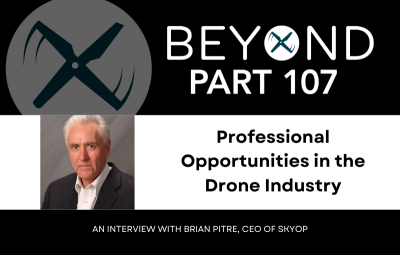How do you launch a career in the drone industry? What skills and experiences are employers looking for? How can schools better prepare students for jobs in the commercial UAV sector?
These and other questions are explored in the new e-book “The Ultimate Drone Professional Guide.”

The book was written by Brian Pitre, the CEO of SkyOp LLC, a company that offers drone-related training programs for students, businesses, public safety professionals, and others. According to Pitre, the book aims to both educate the public, company leaders, and educators about the variety of opportunities available in the drone industry and provide practical career advice to would-be drone professionals.
“The book is my attempt to make the world better understand what's going on with drones—the use cases, the different jobs,” he explained. “I think the public at large just doesn’t understand drones, so what we're trying to do is give them references to the many applications of the technology and to create career pathways in the drone industry.”
For the book, Pitre adapted a series of articles he wrote for the Forbes Technology Council. Chapters explore topics such as getting business leaders started with drones, how to become an sUAS pilot, advances in urban air mobility, and why community colleges should invest in drone certification programs.
According the Pitre, the book fills gaps in the education and understanding about UAV technology. “Around 2012, I became fascinated with drones, and I started talking to people to see what the market was like,” he explained. “Over the years, I've come to the conclusion that many people really need help because they don't know what the industry is all about or how to get into it.”
Specifically, Pitre sees significant misconceptions around how drones can be applied to business operations and how educational institutions approach the technology. “At SkyOp, we do corporate training, and we do licensing to schools and colleges with our curriculum. The level of naiveté that's out there in the marketplace always surprises me,” he stated.
Many in the business world, he said, are simply not aware of the many applications of the technology. “Drones are a transformative tool that affects all businesses, and that’s substantiated by the number of use cases out there,” Pitre stated. “What we're trying to do with the guide is to provide a reference for these uses and applications. For example, we can explain to businesses that drones represent a way to collect data that is better than any other form. We’re really trying to educate companies.”
The “Ultimate Drone Professional Guide” is also trying to educate educators. “Schools have been doing robotics programs for years now, and many of them have decided to do the same thing with drones that they do with terrestrial robotics but that is not the right way to approach it because drones are so advanced now,” Pitre said.
The addition of artificial intelligence in uncrewed systems, the need for comprehensive flight planning by drone pilots, the sophistication of post-processing for data collected by drones, and other factors point to the need for new approaches in education. “One of the problems when we are we're dealing with educational institutions is that some think if you get an FAA Part 107, that will be your job ticket, but nothing could be further from the truth,” Pitre stated.
Ultimately, Pitre hopes the “Ultimate Drone Professional Guide” will bring clarity and direction to businesses looking to adopt drones, job seekers looking to work with the technology, and educators attempting to keep pace with change.
“We're lagging behind what the industry needs, and it’s important that we address that because there are lots of opportunities that people can pursue,” Pitre asserted. “We’re trying to get people to understand that there are thousands of use cases for how we can use drones right now, and there are many applications that haven’t been invented yet. We hope the guide can point people in the right directions.”
Click here for a copy of “The Ultimate Drone Professional Guide.”















Comments